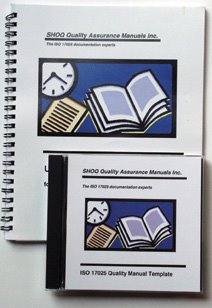 ISO 17025 Quality Manual Template
ISO 17025 Quality Manual Template
Tuesday, June 24, 2008
Laboratory Testing and Analysis Control
Control measures are necessary to identify sources of measurement error within the laboratory and to estimate their bias and variability (repeatability and reproducibility).
The following control measures could be implemented in the laboratory:
- function checks performed by the technician to check the validity of the sample and performance of the equipment
- control checks performed during the anlaysis or testing process. These checks are used to:
a. determine the performance of the analytical or testing system
b. quantitate the variability of results from the analysis or test in terms of precisison and accuracy.
The frequency of checks will be determined by ruggedness, precision, accuracy of the method, dependability of the technician, precision and sensitivity of the instrument, difficulty and time length of the test method.
The data from the check analyses or tests will be compared with that from the analyses or tests and tested for significant differences. Any significant differences will be reported to the Lab Director. The Quality Manager will prepare a regular report showing the percent of significantly different check analyses that occurred during that period and recommend corrective action.
Control charts should be set up and used to record results from selected function and control checks to determine when or if the testing or analytical process is out of control and to record the results of corrective action taken.
Function checks should be performed to verify the stability and validity of the sample and the performance of testing and analytical equipment. The testing or analytical technician will be provided with written performance specifications for each function check, accompanied by recommended action if the specifications are not met. Function checks are measurement specific.
Control checks should be performed during the analytical or testing process. These checks are made on all analyses or tests and intermittently after a specified number of procedures have been completed. Some control checks may be required as part of the routine analysis or test, and are performed by the analyst to determine the performance of the system. These control checks include the use of sample blanks to observe zero concentration drift, introduction of spiked samples to determine percentage of sample recovery during intermediate extraction steps, and processing of sample aliquots to observe within and between run variability for the entire analysis. Other control checks are performed by the analyst intermittently to quantitate analysis variability in terms of precision and accuracy. Control samples normally used for this purpose are sample aliquots to determine precision and standard reference materials to determine accuracy in addition to precision.
Results from selected function checks and control samples will be recorded on control charts to track events showing that the system is out of control; to indicate what part of the system is the source of the error; to provide an indication of the results of any corrective action taken. The QC Technician is responsible for the establishment and monitoring of any control charts needed for lab performance control.
The following control measures could be implemented in the laboratory:
- function checks performed by the technician to check the validity of the sample and performance of the equipment
- control checks performed during the anlaysis or testing process. These checks are used to:
a. determine the performance of the analytical or testing system
b. quantitate the variability of results from the analysis or test in terms of precisison and accuracy.
The frequency of checks will be determined by ruggedness, precision, accuracy of the method, dependability of the technician, precision and sensitivity of the instrument, difficulty and time length of the test method.
The data from the check analyses or tests will be compared with that from the analyses or tests and tested for significant differences. Any significant differences will be reported to the Lab Director. The Quality Manager will prepare a regular report showing the percent of significantly different check analyses that occurred during that period and recommend corrective action.
Control charts should be set up and used to record results from selected function and control checks to determine when or if the testing or analytical process is out of control and to record the results of corrective action taken.
Function checks should be performed to verify the stability and validity of the sample and the performance of testing and analytical equipment. The testing or analytical technician will be provided with written performance specifications for each function check, accompanied by recommended action if the specifications are not met. Function checks are measurement specific.
Control checks should be performed during the analytical or testing process. These checks are made on all analyses or tests and intermittently after a specified number of procedures have been completed. Some control checks may be required as part of the routine analysis or test, and are performed by the analyst to determine the performance of the system. These control checks include the use of sample blanks to observe zero concentration drift, introduction of spiked samples to determine percentage of sample recovery during intermediate extraction steps, and processing of sample aliquots to observe within and between run variability for the entire analysis. Other control checks are performed by the analyst intermittently to quantitate analysis variability in terms of precision and accuracy. Control samples normally used for this purpose are sample aliquots to determine precision and standard reference materials to determine accuracy in addition to precision.
Results from selected function checks and control samples will be recorded on control charts to track events showing that the system is out of control; to indicate what part of the system is the source of the error; to provide an indication of the results of any corrective action taken. The QC Technician is responsible for the establishment and monitoring of any control charts needed for lab performance control.
Labels: accuracy, qc, quality control